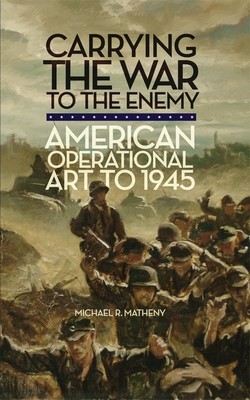
- We will send in 10–14 business days.
- Author: Michael R Matheny
- Publisher: University of Oklahoma Press
- ISBN-10: 080614324X
- ISBN-13: 9780806143248
- Format: 15 x 22.6 x 2.5 cm, softcover
- Language: English
- SAVE -10% with code: EXTRA
Reviews
Description
Surprising new evidence of operational art among U.S. commanders in World War II Military commanders turn tactics into strategic victory by means of "operational art," the knowledge and creative imagination commanders and staff employ in designing, synchronizing, and conducting battles and major operations to achieve strategic goals. Until now, historians of military theory have generally agreed that modern operational art developed between the first and second world wars, not in the United States but in Germany and the Soviet Union, whose armies were supposedly the innovators and greatest practitioners of operational art. Some have even claimed that U.S. forces struggled in World War II because their commanders had no systematic understanding of operational art. Michael R. Matheny believes previous studies have not appreciated the evolution of U.S. military thinking at the operational level. Although they may rightly point to the U.S. Army's failure to modernize or develop a sophisticated combined arms doctrine during the interwar years, they focus too much on technology or tactical doctrine. In his revealing account, Matheny shows that it was at the operational level, particularly in mounting joint and combined operations, that senior American commanders excelled-and laid a foundation for their country's victory in World War II. Matheny draws on archival materials from military educational institutions, planning documents, and operational records of World War II campaigns. Examining in detail the development of American operational art as land, sea, and air power matured in the twentieth century, he shows that, contrary to conventional wisdom, U.S. war colleges educated and trained commanders during the interwar years specifically for the operational art they employed in World War II. After 1945, in the face of nuclear warfare, the American military largely abandoned operational art. But since the Vietnam War, U.S. commanders have found operational art increasingly important as they pursue modern global and expeditionary warfare requiring coordination among multiple service branches and the forces of allied countries. Michael R. Matheny retired after 30 years with the U.S. Army to earn a Ph.D. in military history and join the faculty of the Department of Military Strategy, Planning, and Operations at the U.S. Army War College, Carlisle Barracks, Pennsylvania
EXTRA 10 % discount with code: EXTRA
The promotion ends in 17d.19:42:12
The discount code is valid when purchasing from 10 €. Discounts do not stack.
- Author: Michael R Matheny
- Publisher: University of Oklahoma Press
- ISBN-10: 080614324X
- ISBN-13: 9780806143248
- Format: 15 x 22.6 x 2.5 cm, softcover
- Language: English English
Surprising new evidence of operational art among U.S. commanders in World War II Military commanders turn tactics into strategic victory by means of "operational art," the knowledge and creative imagination commanders and staff employ in designing, synchronizing, and conducting battles and major operations to achieve strategic goals. Until now, historians of military theory have generally agreed that modern operational art developed between the first and second world wars, not in the United States but in Germany and the Soviet Union, whose armies were supposedly the innovators and greatest practitioners of operational art. Some have even claimed that U.S. forces struggled in World War II because their commanders had no systematic understanding of operational art. Michael R. Matheny believes previous studies have not appreciated the evolution of U.S. military thinking at the operational level. Although they may rightly point to the U.S. Army's failure to modernize or develop a sophisticated combined arms doctrine during the interwar years, they focus too much on technology or tactical doctrine. In his revealing account, Matheny shows that it was at the operational level, particularly in mounting joint and combined operations, that senior American commanders excelled-and laid a foundation for their country's victory in World War II. Matheny draws on archival materials from military educational institutions, planning documents, and operational records of World War II campaigns. Examining in detail the development of American operational art as land, sea, and air power matured in the twentieth century, he shows that, contrary to conventional wisdom, U.S. war colleges educated and trained commanders during the interwar years specifically for the operational art they employed in World War II. After 1945, in the face of nuclear warfare, the American military largely abandoned operational art. But since the Vietnam War, U.S. commanders have found operational art increasingly important as they pursue modern global and expeditionary warfare requiring coordination among multiple service branches and the forces of allied countries. Michael R. Matheny retired after 30 years with the U.S. Army to earn a Ph.D. in military history and join the faculty of the Department of Military Strategy, Planning, and Operations at the U.S. Army War College, Carlisle Barracks, Pennsylvania


Reviews